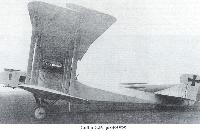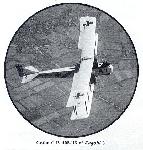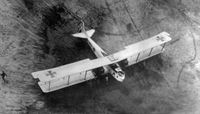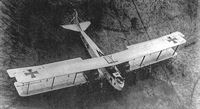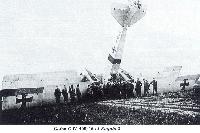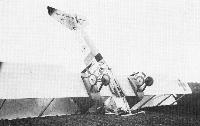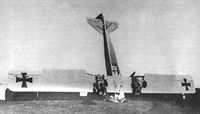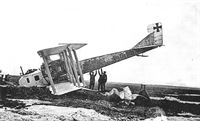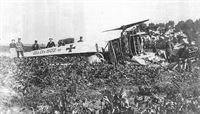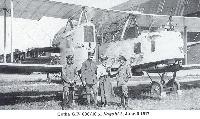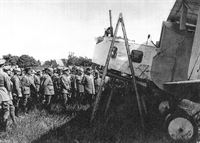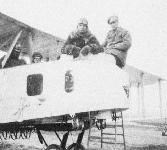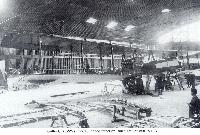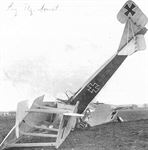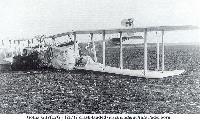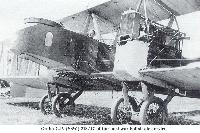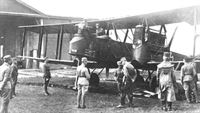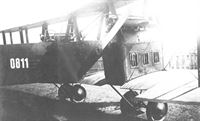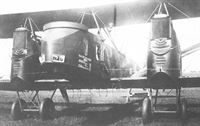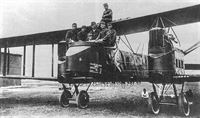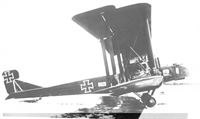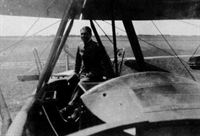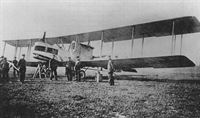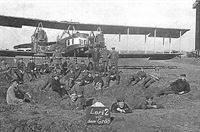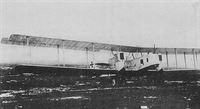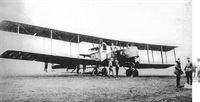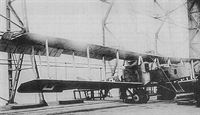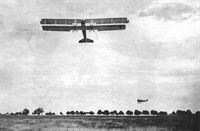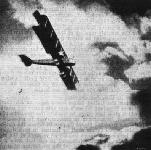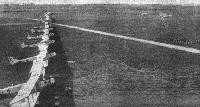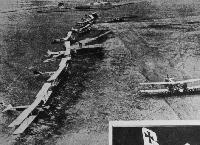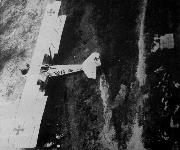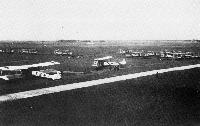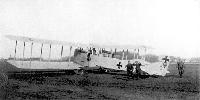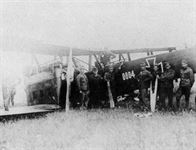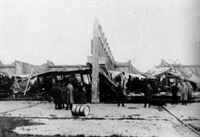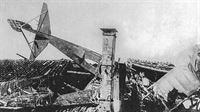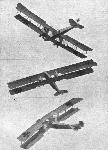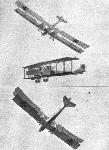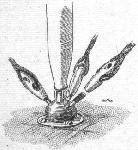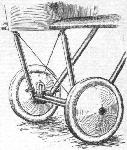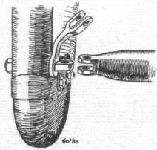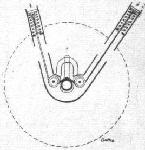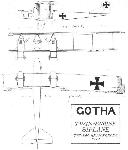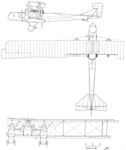
Описание
Страна: Германия
Год: 1916
Twin-engined long-range bomber
Варианты
- Gotha - G.II/G.III - 1916 - Германия
- Gotha - G.IV - 1916 - Германия
- Gotha - G.V - 1917 - Германия
- В.Кондратьев Самолеты первой мировой войны
- O.Thetford, P.Gray German Aircraft of the First World War (Putnam)
- J.Herris Gotha Aircraft of WWI (A Centennial Perspective on Great War Airplanes 6)
- M.Dusing German Aviation Industry in WWI. Volume 1 (A Centennial Perspective on Great War Airplanes 84)
- P.Grosz, G.Haddow, P.Shiemer Austro-Hungarian Army Aircraft of World War One (Flying Machines)
- E.Hauke, W.Schroeder, B.Totschinger Die Flugzeuge der k.u.k. Luftfahrtruppe und Seeflieger 1914-1918
- Журнал Flight
-
J.Herris - Development of German Warplanes in WWI /Centennial Perspective/ (1)
Gotha G.IV 405/16 flown by Oblt. von Trotha, deputy commander of Kagohl 3 on daylight bombing raids over the UK. The overall light blue color was camouflage to render the aircraft less visible at high altitude. The yellow and black stripes were a personal marking. Note the bomb under the nose; the G.IV was tail heavy after the bombs were dropped.
-
J.Herris - Gotha Aircraft of WWI /Centennial Perspective/ (6)
Gotha G.IV 405/16 of Oblt. Hans Freiherr Ulrich von Trotha, deputy commander of KG3, May/June 1917
-
J.Herris - Gotha Aircraft of WWI /Centennial Perspective/ (6)
Gotha G.IV 408/16 of KG3, May/June 1917.
-
В.Кондратьев - Самолеты первой мировой войны
Gotha G-IV (410/16), 13 эскадрилья, 3 бомбардировочная эскадра ВВС Германии, 1917г.
-
J.Herris - Gotha Aircraft of WWI /Centennial Perspective/ (6)
Gotha G.IV 604/16 of KG3, May/June 1917.
-
J.Herris - Gotha Aircraft of WWI /Centennial Perspective/ (6)
Gotha G.IV serial unconfirmed but thought to be 624/16, Hptm. Ernst Brandenburg, C.O. of KG3, May/June 1917. Brandenburg was awarded the Pour le Merite for leading KG3 to bomb London
-
J.Herris - Gotha Aircraft of WWI /Centennial Perspective/ (6)
Gotha G.IV(LVG) 991/16 MoRoTas of Lt. Mons, Lt. Roland, and third, unknown crewman of KG3, February-March 1918
-
J.Herris - Gotha Aircraft of WWI /Centennial Perspective/ (6)
Gotha G.IV(LVG) 08.12 of Flik 102/G of the Austro-Hungarian Air Service
-
J.Herris - Gotha Aircraft of WWI /Centennial Perspective/ (6)
Gotha G.IV(LVG), serial unknown, of KG3
-
J.Herris - Gotha Aircraft of WWI /Centennial Perspective/ (6)
Gotha G.IV(LVG), serial unknown, of KG3, Summer 1917
-
J.Herris - Gotha Aircraft of WWI /Centennial Perspective/ (6)
Gotha G.IV, serial unknown, of KG3
-
J.Herris - Gotha Aircraft of WWI /Centennial Perspective/ (6)
Gotha G.IV, serial unknown, of KG3, Summer 1917
-
J.Herris - Gotha Aircraft of WWI /Centennial Perspective/ (6)
Gotha G.IV LoRi2 flown by Lt. Kurt Kuppers and Oblt. Fritz Lorenz of Staffel 16, KG3
-
Сайт - Pilots-and-planes /WWW/
Gotha G.IV prototype
-
Сайт - Pilots-and-planes /WWW/
Gotha G.IV prototype
-
Сайт - Pilots-and-planes /WWW/
Gotha G.IV 405/16 of Kagohl 3
-
J.Herris - Development of German Warplanes in WWI /Centennial Perspective/ (1)
For its role in bombing London by day in the summer of 1917 the Gotha G.IV shocked the world and became by far the most famous German bomber of the war. G.IV 408/16 was one of those raiders; an additional fuel tank is mounted on top of the upper wing center section to enable the bomber to fly to London from based in Belgium and return. The normal crew was a pilot, a bombardier/front gunner, and a rear gunner. The G.IV and G.V had a tunnel in the rear fuselage enabling the rear gunner to fire downward through the fuselage, a definite surprise for an intercepting fighter. The G.IV and similar G.V were powered by the 260 hp Mercedes D.IVa engine.
-
J.Herris - Gotha Aircraft of WWI /Centennial Perspective/ (6)
Gotha G.IV 408/16 was a bomber assigned to Kagohl 3, the England Geschwader, the unit assigned to bomb Britain. Two fuel tanks are mounted above the upper wing to give it enough range for these missions.
-
J.Herris - Gotha Aircraft of WWI /Centennial Perspective/ (6)
Gotha G.IV 408/16 of Kagohl 3 after full tactical markings were applied. The letters on the fuselage side are likely the initials of two of the crew members, a common marking practice in Kagohl 3.
The Gotha G.IV was one of the aircraft that bombed London in daylight. The engine nacelles of the G.IV were large and extended to the lower wing. The rear gunner's cockpit had protective screens on both sides to prevent him from leaning into the propellers. The additional fuel tank on top of the upper wing was needed for these long-range missions. The control cables were routed outside the fuselage, where they created additional drag and contributed to the type's stately maximum speed of 140 kmh (87 mph). -
Сайт - Pilots-and-planes /WWW/
Gotha G.IV 409/16 of Kagohl 3
-
A.Imrie - German Bombers /Arms & Armour/
Gotha G IV 409/16 of Kasta 13, Kagohl III, on its nose after an emergency landing in a ploughed field, 10 May 1917. The frail nose structure could not stand up to this sort of thing and was one of the reasons why the nose cockpit was unmanned during take-offs and landings. The Gotha auxiliary landing gear of the 'stossfahrgestell' (shockundercarriage) type would have prevented damage such as this, but it was not introduced to production aircraft until over a year later. The unfused bombs show that the aircraft was on a practice flight. Other points of interest are the mudguards behind each undercarriage wheel to prevent mud and stones being flung off the tyres into the pusher propellers, and the recess of the well-known Gotha tunnel of the rear fuselage which allowed the rear gunner to fire aft and down into what was previously considered a blind spot.
-
J.Herris - Gotha Aircraft of WWI /Centennial Perspective/ (6)
Gotha G.IV 410/16 of Kagohl 3 after a crash during take-off on April 23, 1917. The "Gotha Tunnel" that enabled the rear gunner to fire downward and to the rear is shown to advantage.
-
J.Herris - Gotha Aircraft of WWI /Centennial Perspective/ (6)
Gotha G.IV 410/16 of Kagohl 3.The early Gotha G.IV bombers were painted light blue overall with natural metal engine cowlings.
-
Сайт - Pilots-and-planes /WWW/
An early Gotha G.IV, possibly G.410/16
-
J.Herris - Gotha Aircraft of WWI /Centennial Perspective/ (6)
An early Gotha G.IV, possibly 610/16, wears an over-size Gotha company trademark below the iron cross insignia on the rudder.
-
J.Herris - Gotha Aircraft of WWI /Centennial Perspective/ (6)
A factory photograph of Gotha G.IV 601/16 after a landing accident. All aircraft design decisions are compromises between competing concerns, but landing accidents claimed 76% of the Gotha G.IV and G.V bombers lost to all causes. If the CG is too far forward, the aircraft is excessively stable, too much download is required on the tail, raising the nose to abort a landing becomes difficult, and nose-overs become more likely. However, the extreme number of landing accidents is proof that Burkhardt moved the center of gravity too far aft during development of the G.II, a mistake that could have been easily rectified but was not.
-
J.Herris - Gotha Aircraft of WWI /Centennial Perspective/ (6)
Gotha G.IV 602/16 crash-landed in neutral Holland at Sas van Gent on 28 September 1917 during a night raid on Britain. Another G.IV crashed and burned at Sneek the same day.
-
J.Herris - Gotha Aircraft of WWI /Centennial Perspective/ (6)
A Gotha G.IV 603/16 of Kagohl 3, the England Geschwader, with its crew. Gotha was a relatively obscure manufacturer until the dramatic daylight bombing raid on London by Gotha G.IV bombers of Kagohl 3 on 13 June 1917. This shocked the world and instantly made "Gotha" a household name. The Gotha G.IV is by far the most famous and significant Gotha type.
-
Сайт - Pilots-and-planes /WWW/
Gotha G.IV 606/16 of Kagohl 3, June 5, 1917
-
M.Dusing - German Aviation Industry in WWI. Volume 1 /Centennial Perspective/ (84)
A factory photograph of Gotha G.IV 607/16 carrying six 50-kg PuW bombs beneath the fuselage. The far-forward carriage of the bombs under the nose illustrate the tail-heaviness of the basic design. The bombardier/forward gunner normally carried a number of 12.5 kg bombs in bomb racks inside his cockpit, which partially compensated for the center of gravity problems, at least until they were dropped.
-
J.Herris - Gotha Aircraft of WWI /Centennial Perspective/ (6)
General Hindenburg and party inspect a Gotha G.IV, probably 612/16 if the lettering on the wheel cover is correct. The extreme forward mounting of the bombs below the nose clearly indicates the aircraft was tail-heavy after bombs were released.
-
A.Imrie - German Bombers /Arms & Armour/
Leutnant Scharffenberg of Kasta 13, Kagohl III, in the front cockpit (in flying kit) with the crew of his Gotha G IV 625/16. The steel retaining bands for the P.u.W. bombs in the racks under the fuselage and the provision for the forward carriage of bombs under the nose to alleviate the extreme tail-heaviness of this aeroplane can clearly be seen. Also visible under the nose is the streamlined fairing for the prism and mounting gimbals of the Goerz telescope bombsight. With bombs and most of the fuel gone, the Gotha G IV was almost unmanageably tail-heavy, a factor that was responsible for a large number of landing accidents.
-
Сайт - Pilots-and-planes /WWW/
Gotha G.IV(SSW) 1055/16 landed intact on Dutch soil, August 18, 1917.
-
J.Herris - Gotha Aircraft of WWI /Centennial Perspective/ (6)
Gotha G.IV(LVG) 106/17 in a pose too often typical of a Gotha bomber.
-
Сайт - Pilots-and-planes /WWW/
Gotha G.IV(LVG) 121/17 crash-landed Geschwaderschule Paderborn.
-
J.Herris - Gotha Aircraft of WWI /Centennial Perspective/ (6)
Gotha G.IV(SSW) G.211/17 delivered on March 14, 1918 to the Geschwaderschule Paderborn was one of the aircraft used to evaluate design modifications. Here it is fitted with 260 hp Mercedes D.IVa engines mounted in tractor configuration and fitted with four-bladed propellers. In this installation the radiators were suspended from the upper wing.
-
Сайт - Pilots-and-planes /WWW/
Gotha G.IV(SSW) 213/17 of the post-war Polish air service.
-
M.Kabatek, Fr.R.Kulczynski - German Aircraft in Polish Service. Volume 1 /Aeronaut/
Halberstadt Cl.IIa (Bay) 2869/18, in the middle of the photo, during an overhaul in the summer of 1919 at the workshops of the Stacja Lotnicza Lawica. Gotha G.IV (SSW) 213/17 bomber is in the background. (Wojciech Sankowski)
Другие самолёты на фотографии: Halberstadt CL.II/CL.IIa - Германия - 1917
-
Сайт - Pilots-and-planes /WWW/
Gotha G.IV(SSW) 213/17 of the post-war Polish air service.
-
J.Herris - Siemens-Schuckert Aircraft of World War I /Centennial Perspective/ (12)
The SSW factory producing D.III fighters and Gotha G.IV(SSW) bombers; 80 Gothas were built under license.
Другие самолёты на фотографии: Siemens-Schuckert D.II/D.III/D.IV - Германия - 1917
-
M.Dusing - German Aviation Industry in WWI. Volume 1 /Centennial Perspective/ (84)
"G hangar" of the LVG in Johannisthal.
-
M.Dusing - German Aviation Industry in WWI. Volume 1 /Centennial Perspective/ (84)
"G hangar" of the LVG in Johannisthal.
-
M.Dusing - German Aviation Industry in WWI. Volume 1 /Centennial Perspective/ (84)
Working on a Go G.IV(LVG).
-
P.Grosz, G.Haddow, P.Shiemer - Austro-Hungarian Army Aircraft of World War One /Flying Machines/
Gotha G.IV(LVG) 08.05 with a group of LPT officers of Flik 103/G awaiting inspection by Archduke Joseph on 20 May 1918. A propeller-driven dynamo is affixed to the inner wing strut.
-
P.Grosz, G.Haddow, P.Shiemer - Austro-Hungarian Army Aircraft of World War One /Flying Machines/
On the Aviano airfield, Flik 101/G mechanics assemble the Gotha G.IV(LVG) 08.10 in April 1918. The engine-undercarriage module is awaiting installation in the background. The bomber was destroyed in an emergency landing on 15 September 1918.
-
P.Grosz, G.Haddow, P.Shiemer - Austro-Hungarian Army Aircraft of World War One /Flying Machines/
Gotha G.IV(LVG) 08.11. The rear gunner’s position has wire guards to protect the gunner from the rotating propellers. Similarly, the undercarriage is fitted with wire guards to prevent stones and debris from flying into the propellers.
-
P.Grosz, G.Haddow, P.Shiemer - Austro-Hungarian Army Aircraft of World War One /Flying Machines/
Gotha G.IV(LVG) 08.11 showing the landing lights that were installed by the LFT. This was one of the five Gotha bombers destroyed in the storm of 23/24 September 1918.
-
J.Herris - Gotha Aircraft of WWI /Centennial Perspective/ (6)
Austro-Hungarian Gotha G.IV(LVG) 08.12 has drawn a crowd. The bomb racks are visible under the wing center section. Because German engine production was inadequate for German needs due to Allied numerical superiority and the Royal Navy's distant blockade, the Austrians had to provide their own 230 hp Hiero engines for their Gothas. The revised engine installation was a disaster; weak engine bearers and unsuitable propellers caused excessive engine vibration that led to piping leaks and failures of the structure and instruments. Despite great efforts by the maintenance staff, by late September the Austrian Gothas were virtually grounded and the aircrews reverted to the reliable, single-engine Brandenburg C.I for most bombing missions.
-
P.Grosz, G.Haddow, P.Shiemer - Austro-Hungarian Army Aircraft of World War One /Flying Machines/
The Gotha G.IV(LVG) 08.20 was modified at Aspern in July 1918 and given reinforced engine bearers, new radiator jalousies, and improved carburetor controls.
Gotha G.IV-Bomber, Flugzeugnummer 08.20; das Flugzeug war in Aspern bei Propellerversuchen eingeteilt
Бомбардировщик Gotha G.IV, самолет № 08.20; самолет был назначен на испытания пропеллеров в Асперне. -
E.Hauke, W.Schroeder, B.Totschinger - Die Flugzeuge der k.u.k. Luftfahrtruppe und Seeflieger 1914-1918
Gotha G.IV. Flugzeugnummer 08.20, am Heckstand sitzend der TO Oblt Klement Adamec
Gotha G.IV. Самолет номер 08.20, TO Oblt Klement Adamec сидит в задней оборонительной установке -
J.Herris - Gotha Aircraft of WWI /Centennial Perspective/ (6)
A Gotha G.IV(LVG) in Austro-Hungarian service.The 39 Austro-Hungarian G.IV(LVG) bombers delivered were assigned Austrian serials 08.01-08.40; one had crashed in a "typical landing accident" by an LVG pilot and was not replaced. These aircraft had twin fuel tanks above the wing center section and were camouflaged in dark German hexagonal fabric for night bombing.
-
Сайт - Pilots-and-planes /WWW/
Gotha G.IV
-
J.Herris - Gotha Aircraft of WWI /Centennial Perspective/ (6)
Gotha G.IV of Kagohl 3, the England Geschwader, the unit assigned to bomb Britain.There are bombs under the extreme nose of the airplane; this unusual placement was due to the tail-heaviness of the Gotha bombers. Once the bombs were released the Gothas became neutrally stable or unstable in pitch, resulting in numerous landing accidents that destroyed more Gotha bombers than all other causes combined. At this remove it is difficult to understand why Gotha did not fix the tail-heaviness problem before the bombers were produced in quantity. Regardless, these bombers were Gotha's major success as an aircraft manufacturer. Without them Gotha would have little reputation in aviation.
-
J.Herris - Gotha Aircraft of WWI /Centennial Perspective/ (6)
Front view of an unidentified Gotha G.IV. From this vantage point the actuating strut between upper and lower ailerons confirms this is a G.IV and not a G.III, which did not have ailerons on the lower wings.
-
M.Dusing - German Aviation Industry in WWI. Volume 1 /Centennial Perspective/ (84)
Gotha G.IV(LVG) (1917)
-
J.Herris - Gotha Aircraft of WWI /Centennial Perspective/ (6)
The crater was made by a British bombing attack on the airfield, but Lori2, flown by Lt. Kurt Kuppers and Oblt. Fritz Lorenz of Staffel 16 seems undamaged other than for its missing engine nacelle panels, which apparently were blown off by the bomb's blast. With typical gallows humor, the sign reads "Lori2 before the grave." The aircraft name is repeated on the rear fuselage. The aircraft is in dark camouflage for night bombing missions.
-
J.Herris - Gotha Aircraft of WWI /Centennial Perspective/ (6)
An early Gotha G.IV painted in light colors for daylight bombing.
-
P.Grosz, G.Haddow, P.Shiemer - Austro-Hungarian Army Aircraft of World War One /Flying Machines/
The first Gotha G.IV(LVG) to land on the Flik 101/G airfield at Aviano is surrounded by curious spectators. The bomber is covered in German, dark-hexagon camouflage fabric.
-
J.Herris - Gotha Aircraft of WWI /Centennial Perspective/ (6)
An unidentified Gotha G.IV at the factory. The twin-wheel Stossfahrgestell (shock landing gear) designed by Siemens was fitted to all SSW-built aircraft from G.217/17, and apparently this G.IV is one of those. Many SSW-built machines were also fitted with the Flettner servo tabs to reduce the control forces, making the aircraft more maneuverable and reducing the pilot's workload.
-
J.Herris - Gotha Aircraft of WWI /Centennial Perspective/ (6)
This photograph of an operational G.IV being positioned the old-fashioned way was made into a Sanke card. Although the fuselage is still a light color, the wings and tail have been camouflaged in dark lozenge colors for night bombing raids over Britain. It is an interesting safety note that the aircraft is carrying bombs while being moved.
The prototype Gotha G IV took to the air for the first time during December 1916. Larger than the preceding Gotha G III, the G IV was powered by two 260hp Mercedes D IVa engines that propelled it along at 87mph at 11,880 feet. With a full 1,100 Ib bomb load, the range of the 3-man G IV was 304 miles, extending further as bomb load was reduced and traded for additional fuel. Armed with three 7.92mm Parabellums, one of these was positioned in the aircraft's belly to catch the unwary attacker. -
J.Herris - Gotha Aircraft of WWI /Centennial Perspective/ (6)
A Gotha G.IV, confirmed by the aileron actuating strut, takes off. It is painted in light colors for daylight bombing.
-
H.Cowin - Aviation Pioneers /Osprey/
Discernibly in the in-flight image of a G IV, shown here, are two bombs being carried under the nose of the machine, positioned to compensate for the extreme tail-heaviness of the G IV. This inherent design flaw led to many G IVs surviving combat only to crash during the attempt to land back at base. In all, production was reported to have totalled 142 machines, 52 built by the parent company, plus 50 by LVG and 40 from Siemens Schuckert.
-
Журнал - Flight за 1918 г.
The moonlight raider.
-
Журнал - Flight за 1917 г.
A group of the double-engine Gotha raiders, now familiar to these shores, drawn up at their starting-point.
-
Jane's All The World Aircraft 1919 /Jane's/
A Gotha Bombing Squadron about to start.
-
Jane's All The World Aircraft 1919 /Jane's/
A Gotha G.V (G.IV???) Bomber as seen from above, with its handling crew resting in a trench behind it and on the ground round it.
-
A.Imrie - German Bombers /Arms & Armour/
Due to limited fuel and the prevailing westerly wind, Kagohl III used the naval aerodrome at Nieumunster on the Belgian coast as a refuelling point for early raids against south-east England. The first mass attack against London was planned for 18 May 1917 and the Gotha G IVs positioned to Nieumunster; however, the wind remained stronger than forecast and late in the day the aircraft flew back to their main base at Ghent. On 25 May wind conditions were acceptable and again fuelling was undertaken at Nieumunster. In the event cloud obscured London and the 21-aircraft formation dropped 5,200kg of high-explosive on alternative targets in Ashford, Folkestone and Dover. Two Gothas were lost, one over the Channel and one near Brugge on return. It has not been possible to determine which of these dates this photograph of Kagohl III Gotha G IVs at Nieumunster in May 1917 depicts.
-
Сайт - Pilots-and-planes /WWW/
Gotha G.IV bombers at the Kagohl 3 airfield at Nieuwmunster on the Flanders coast.
-
Сайт - Pilots-and-planes /WWW/
Gotha G.IV(SSW)
-
J.Herris - Gotha Aircraft of WWI /Centennial Perspective/ (6)
An unidentified Gotha G.IV after yet another landing accident.
-
J.Herris - Gotha Aircraft of WWI /Centennial Perspective/ (6)
This late-production Gotha G.IV was covered in fabric printed with dark, hexagonal night camouflage for night bombing missions. Another detail of interest are the screens on both sides of the rear gunner's cockpit to prevent him from accidentally putting a hand or arm in the propeller arc.
-
E.Hauke, W.Schroeder, B.Totschinger - Die Flugzeuge der k.u.k. Luftfahrtruppe und Seeflieger 1914-1918
Gotha G.IV-Bomber (L.V.G.), Flugzeugnummer 08.04, im April 1918 von Wr. Neustadt ausgeliefert
-
E.Hauke, W.Schroeder, B.Totschinger - Die Flugzeuge der k.u.k. Luftfahrtruppe und Seeflieger 1914-1918
Gotha G.IV-Bomber 08.06 und 08.11 (rechts), im April 1918 von Wr. Neustadt an den Fiep 1 in Campoformido ausgeliefert. Einsatz bei der Flik 101G, Pordenone. Am 23. September 1918 bei einer Sturmkatastrophe total beschädigt
Бомбардировщики Gotha G.IV 08.06 и 08.11 (справа), апрель 1918 г. из Wr. Neustadt доставлен в Fiep 1 в Кампоформидо. Используется с Flik 101G, Порденоне. Полностью поврежден во время урагана 23 сентября 1918 г. -
J.Herris - Gotha Aircraft of WWI /Centennial Perspective/ (6)
Austro-Hungarian Gotha G.IV(LVG) 08.16 of Flik 102/G was brought down by Italian anti-aircraft fire on 28 July 1918. The slot for the gunner to fire his gun downward through the "Gotha Tunnel" is clearly visible, as is the faired bulge behind it typical for the Gotha G.IV.The dark night camouflage, characterized in the resulting Allied report as "a very black, bluish gray", is evident.
-
Журнал - Flight за 1917 г.
THE GOTHA TWIN-ENGINED BOMBING BIPLANE. - Three-quarter front view.
-
Jane's All The World Aircraft 1919 /Jane's/
The General Scheme of the Gotha Gun-Tunnel.
-
Журнал - Flight за 1917 г.
The interplane strut fitting on the Gotha twin-engined bomber.
-
Журнал - Flight за 1917 г.
THE GOTHA TWIN-ENGINED BOMBER. - One of the under-carriages, in which steel compression springs and cable within the chassis struts, and connected to the axle, takejthe place of rubber shock absorbers.
-
Журнал - Flight за 1917 г.
The attachment of the bracing tie-rod and cable on the chassis of the Gotha bomber.
-
Журнал - Flight за 1917 г.
Diagram showing the shock-absorbing device on the Gotha bomber.
-
Jane's All The World Aircraft 1919 /Jane's/
The Gotha G.IV Bomb Dropper. - Outline views of the twin-engine three-seater biplane used largely for raiding purposes by the Germans. The sketches are reproduced from the French technical paper "L'Aerophile".
-
P.Grosz, G.Haddow, P.Shiemer - Austro-Hungarian Army Aircraft of World War One /Flying Machines/
Gotha G.IV(LVG) Series 08
-
Журнал - Flight за 1917 г.
THE GOTHA TWIN-ENGINED BOMBER. - Plan, front and side elevations to scale.
В.Кондратьев Самолеты первой мировой войны
ГОТА G-IV / GOTHA G-IV
В начале 1917-го появился "Гота" G-IV. На нем применили интересную новинку, никогда более не встречавшуюся в мировом авиастроении. Для защиты от атак истребителей с нижней полусферы в хвостовой части фюзеляжа сделали сквозной трапециевидный вырез, так называемый "тоннель Готы". Задний стрелок мог через этот вырез вести огонь из верхнего пулемета вниз, под фюзеляж и оперение. Прочность фюзеляжа, ослабленную "тоннелем", повысили путем замены полотняной обшивки на фанерную.
G-IV выпускался серийно на нескольких авиазаводах Германии. Фирма Гота построила 50 экземпляров, Симменс-Шуккерт - около 80 и LVG - примерно сотню.
При этом до 40 самолетов Симменс-Шуккерт сделал в учебном варианте с относительно маломощными 180-сильными моторами "Аргус" или NAG.
Весной 1917 года G-IV поступили на вооружение 3-й эскадры тяжелых бомбардировщиков, предназначенной для действий против Великобритании. Летом и осенью этими машинами вооружили еще несколько подразделений на западном, итальянском и балканском фронтах. 25 мая "Готы" совершили первый дневной налет на Лондон.
Начиная с июля они регулярно, днем и ночью бомбили Лондон, Париж и другие города Англии, Франции и Италии. Эти налеты оказывали сильное морально-психологическое воздействие. Чтобы успокоить население, англичанам даже пришлось отзывать истребители с фронта для усиления ПВО метрополии.
В глазах союзников "Гота" стал символом немецкой стратегической авиации. Нередко этим термином называли любой германский двухмоторный бомбардировщик.
Выносливые, хорошо защищенные "Готы" являлись трудным противником для истребителей Антанты. Не более 20 аппаратов было сбито в воздушных боях, чуть больше - огнем зенитной артиллерии. Основной урон германские бомбардировщики несли в результате различных летных происшествий. Одна только 3-я эскадра потеряла в авариях и катастрофах 37 "Гот".
30 "четверок" приобрела Австро-Венгрия. Австрийцы оснастили бомбардировщики собственными 230-сильными моторами "Геро" и весьма активно применяли на итальянском фронте.
ДВИГАТЕЛИ
2 "Мерседеса" D.IVa по 260 л.с.
ВООРУЖЕНИЕ
Носовая и хвостовая турели с пулеметами "Парабеллум". Бомбовая нагрузка - 300-600 кг в зависимости от дальности полета.
ЛЕТНО-ТЕХНИЧЕСКИЕ ХАРАКТЕРИСТИКИ
Размах, м 23,7
Длина, м 12,4
Площадь крыла, кв.м 89,5
Сухой вес, кг 2400
Взлетный вес, кг 3635
Скорость максимальная, км/ч 140
Дальность полета, км 700
Время набора высоты, мин/м 21/3000
Потолок, м 5000
Описание:
















